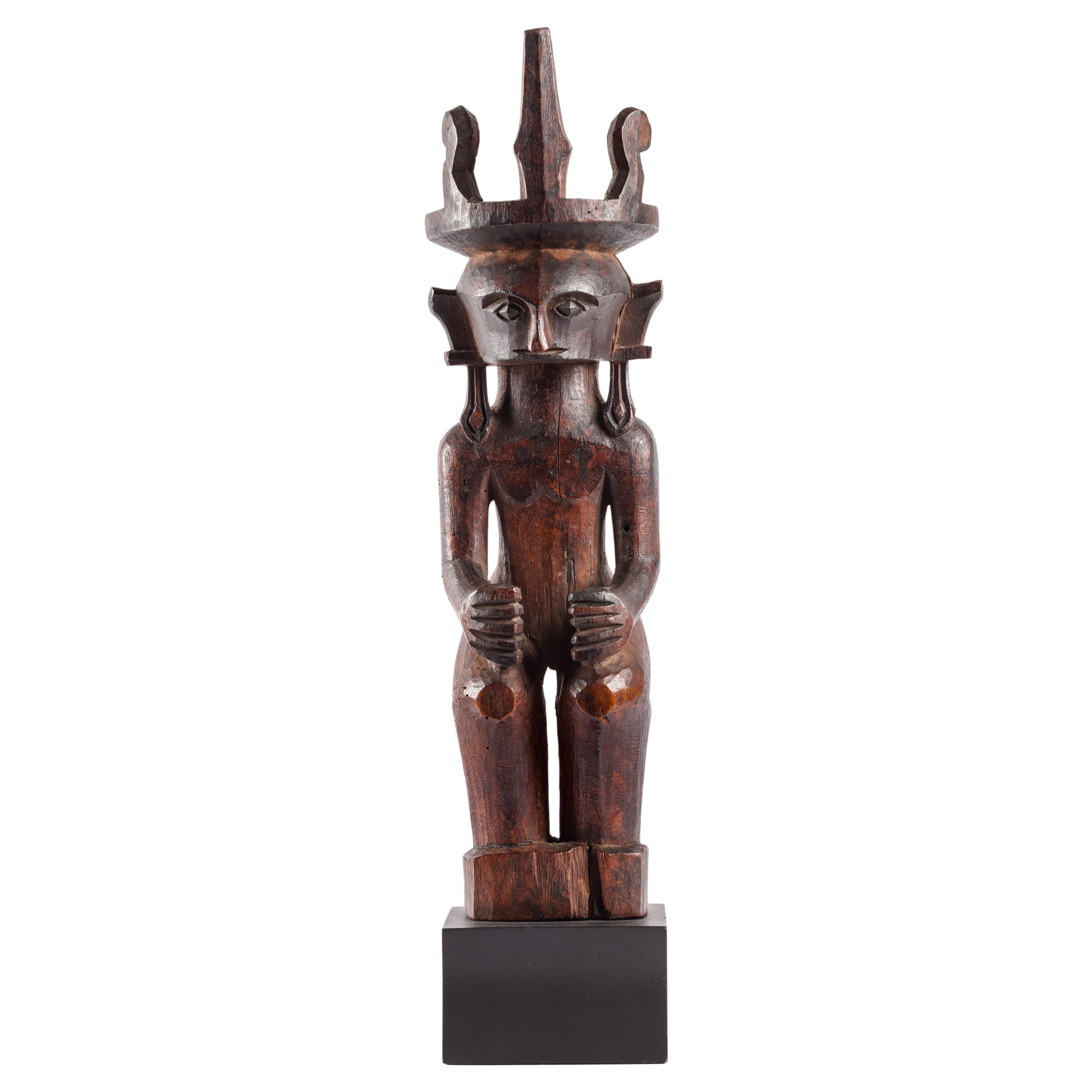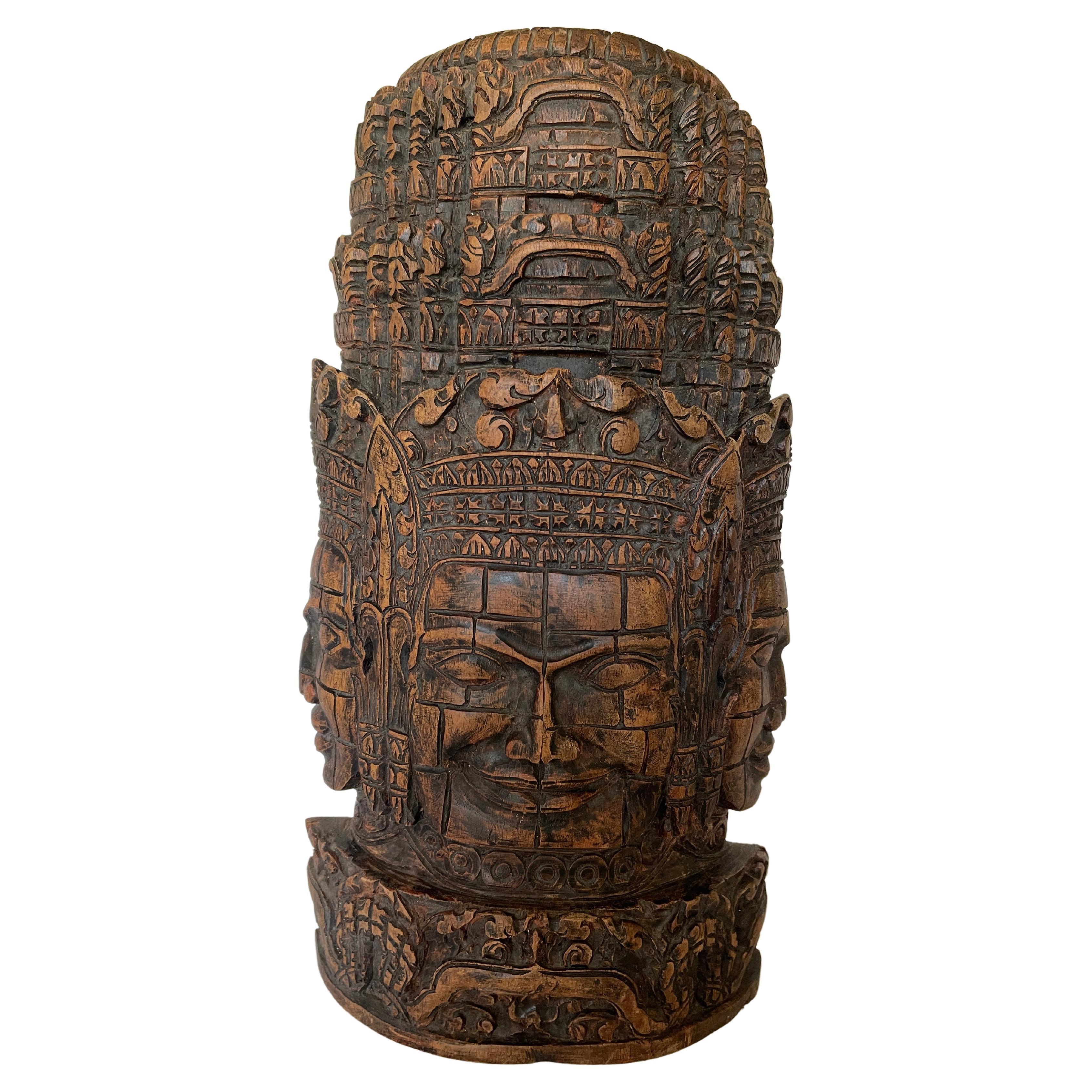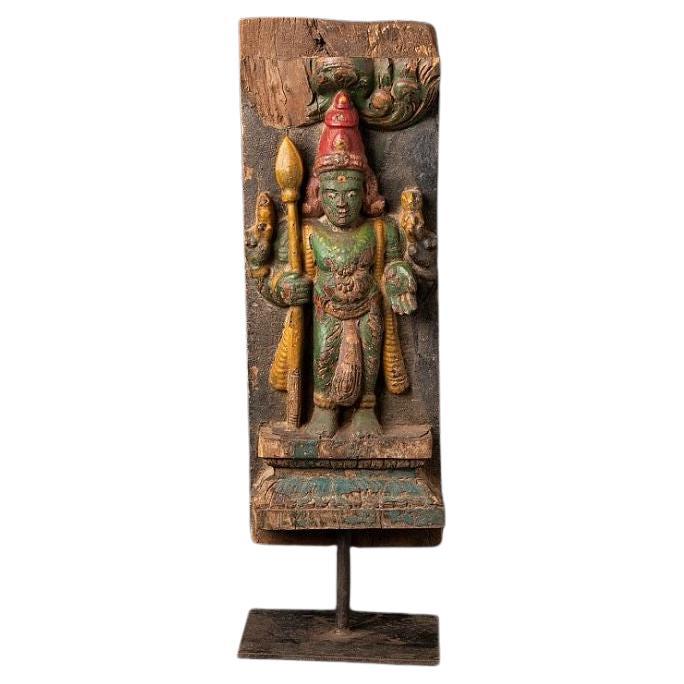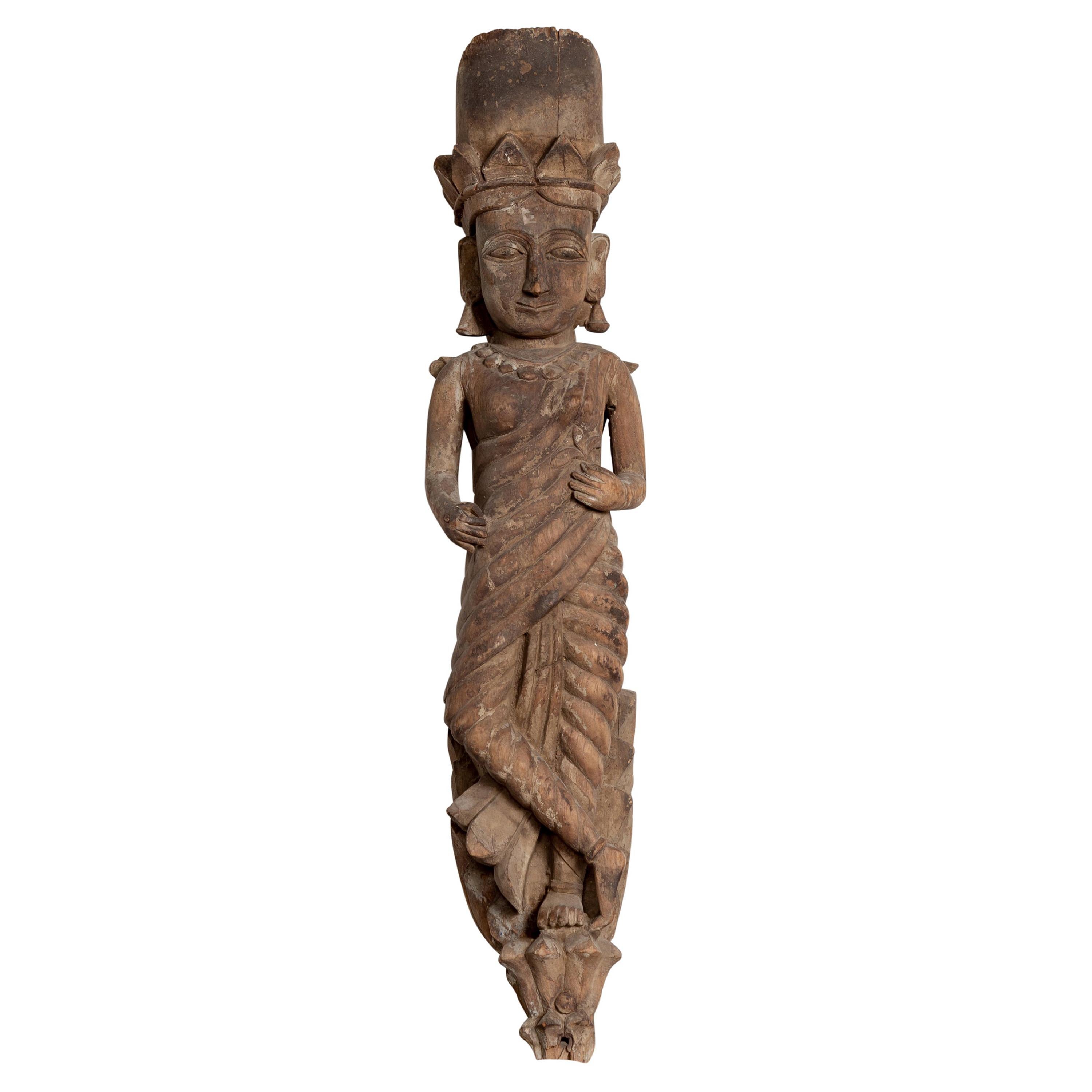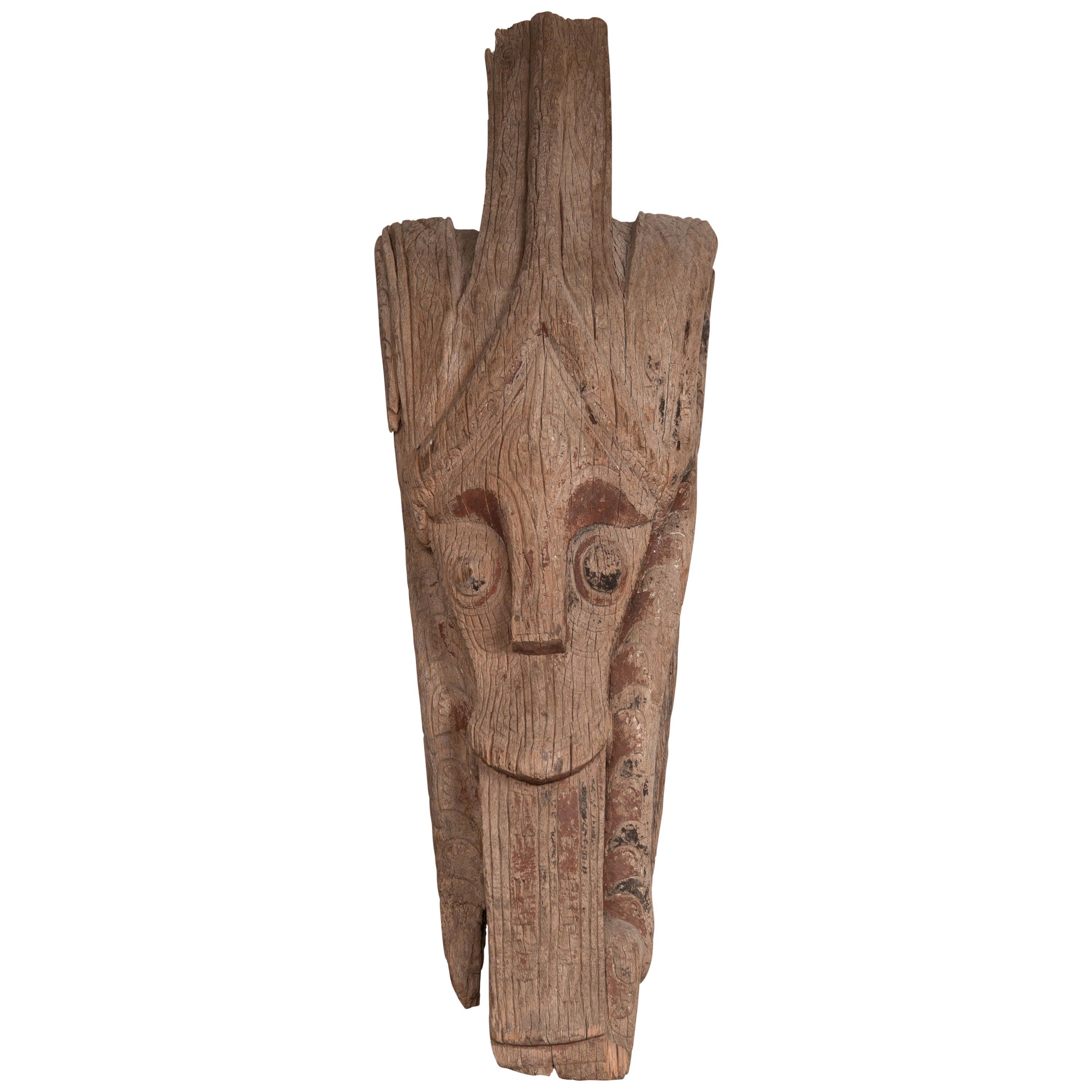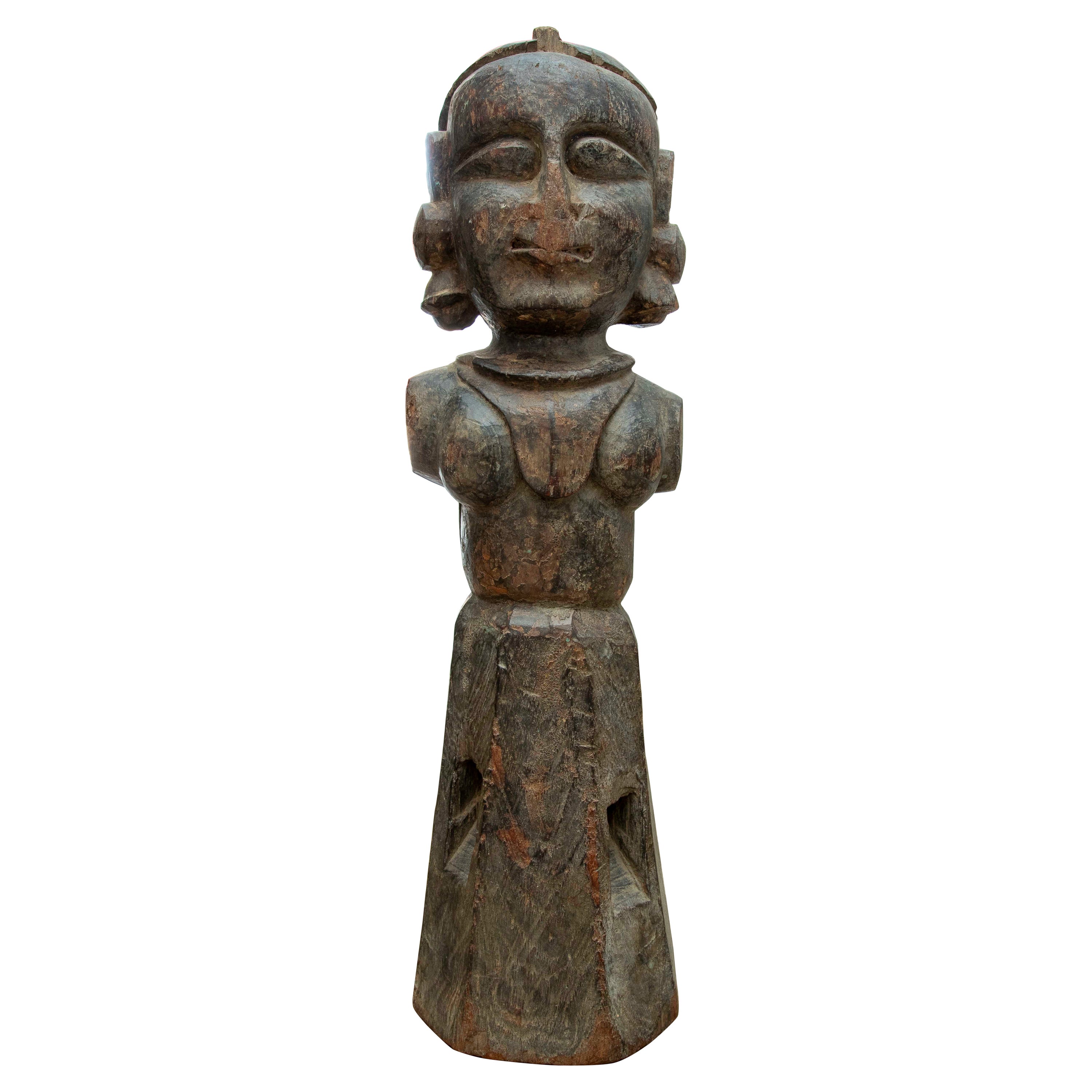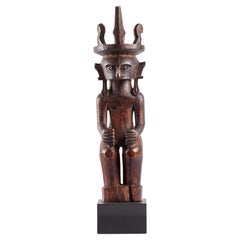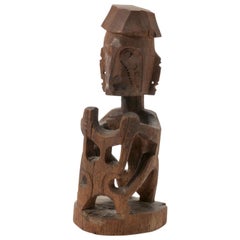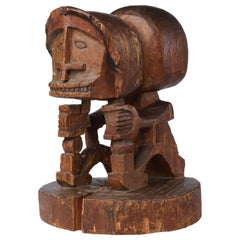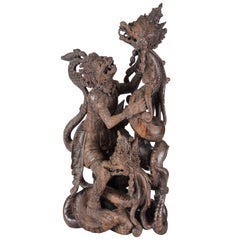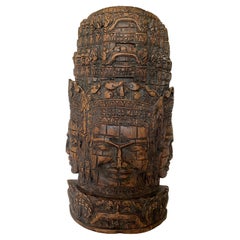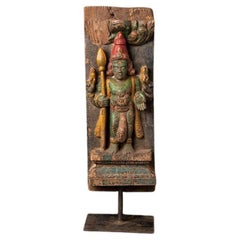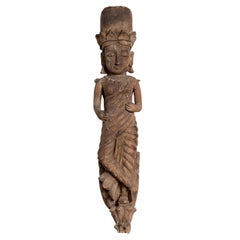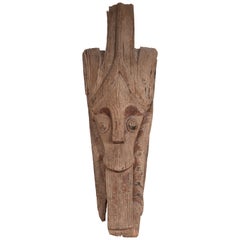Items Similar to Splendid Indo-Portuguese Colonial Sculpture of Nagini from Goa, 17th Century
Want more images or videos?
Request additional images or videos from the seller
1 of 8
Splendid Indo-Portuguese Colonial Sculpture of Nagini from Goa, 17th Century
$4,950
£3,778.63
€4,343.79
CA$6,965.53
A$7,745.96
CHF 4,068.35
MX$94,702.18
NOK 50,695.51
SEK 47,792.18
DKK 32,418.72
About the Item
A fine Indo-Portuguese inlaid teak wood figure of Nagini
India, Goa, 17th century
Measure: H. 55 cm
(with stand, and with ring for wall hanging)
The sculpture can be perceived as such but probably is one of four legs of an Indo-Portuguese contador. These famous profusely inlaid cabinets are possibly the embodiment of colonial furniture. Depicted here are a Naga with a woman’s head and torso and a curling serpent’s lower body. Nagini
is the female version of the Naga, the Sanskrit word for a deity or class of entity or being, taking the form of a giant snake.
In Hindu religious culture, Nagas are considered nature spirits closely associated with water, rivers, lakes and seas, protectors of springs, wells and rivers, propitiating rain, and thus fertility.
They are object of great reverence even in modern times and especially in South India, where they are still worshipped as female deities, particularly by women devotees, bringing them fertility and prosperity. The Nagini serves an apotropaic function when part of a cabinet: to ward off evil intentions by protecting the contents hidden in this type of furniture used to store valuables, such as money, documents, jewellery and precious objects.
- Dimensions:Height: 21.66 in (55 cm)Width: 5.91 in (15 cm)Depth: 5.91 in (15 cm)
- Materials and Techniques:
- Place of Origin:
- Period:
- Date of Manufacture:circa 1650
- Condition:Wear consistent with age and use.
- Seller Location:Amsterdam, NL
- Reference Number:1stDibs: LU5458231674422
About the Seller
5.0
Recognized Seller
These prestigious sellers are industry leaders and represent the highest echelon for item quality and design.
Established in 1985
1stDibs seller since 2020
23 sales on 1stDibs
Typical response time: 5 hours
- ShippingRetrieving quote...Shipping from: Amsterdam, Netherlands
- Return Policy
Authenticity Guarantee
In the unlikely event there’s an issue with an item’s authenticity, contact us within 1 year for a full refund. DetailsMoney-Back Guarantee
If your item is not as described, is damaged in transit, or does not arrive, contact us within 7 days for a full refund. Details24-Hour Cancellation
You have a 24-hour grace period in which to reconsider your purchase, with no questions asked.Vetted Professional Sellers
Our world-class sellers must adhere to strict standards for service and quality, maintaining the integrity of our listings.Price-Match Guarantee
If you find that a seller listed the same item for a lower price elsewhere, we’ll match it.Trusted Global Delivery
Our best-in-class carrier network provides specialized shipping options worldwide, including custom delivery.More From This Seller
View AllA Nias 'Adu Zatua' wooden ancestor sculpture
Located in Amsterdam, NL
Indonesia, Nias, 19th century
H. 37.5 x W. 10 cm
Sculptures like the one present are not only decorative items but are believed to be vessels that house the spirits of ancestors and are used to communicate with them.
After the death of a person a wooden image or Adu Zatua was made to mediate between the human world and the spiritual realm. These kinds of figures were commissioned by noble Nias families, whereas simple and lesser quality carvings generally were found among lower class families.
In this particularly fine example, the sculptor has paid careful attention to the proportions of the different parts of the body, dividing it into three main sections – the head, the torso, and the legs. The shapes are sometimes flat, round, or have notches, but all are perfectly in balance creating a certain divine tranquillity. This Adua Zatua’s ears are decorated with earrings, and it is wearing a headdress, pointing towards a chiefly provenance.
In 1914 the Dutch gained complete control of the island of Nias and started spreading Protestant Christianity. Many ancestor statues...
Category
Antique 19th Century Indonesian Tribal Art
Materials
Wood
Early Papua Korwar Statue, Collection of Missionary Starrenburg, Collected 1909
Located in Amsterdam, NL
A Papua wood figure of a Korwar
North West Irian Jaya, Vogelkop area, coastal Geelvink Bay, present-day Cenderawasih Bay, early 20th century
The seated Korwar is holding an ope...
Category
Early 20th Century Indonesian Tribal Tribal Art
Materials
Wood
Early Papua Korwar Ancestor Figure, Early 19th Century, Deep Black-Brown Patina
Located in Amsterdam, NL
An extremely rare Papua wood sculpture of a Korwar
Papua New Guinea, Cendrawasih Bay, Wandammen, early 19th century
Measures: Height 24 x Diameter 18 cm
Finely carved in th...
Category
Antique Early 19th Century Indonesian Tribal Tribal Art
Materials
Wood
$112,631
Free Shipping
Very Fine and Detailed Balinese Sugarwood Sculpture of a Ramayana Scene
Located in Amsterdam, NL
A fine Balinese Suarwood (Albizia saman) sculpture depicting a scene from the Ramayana
Gianyar, 1970-1980
Measures: H. 48.5 cm
The sculpture depicts a scene from the Ramayana....
Category
20th Century Balinese Sculptures and Carvings
Materials
Wood
A Japanese rootwood sculpture of Gama Sennin
Located in Amsterdam, NL
Edo period, 18th century
H. 11 x W. 15 cm
Sennin’s are ascetics living as hermits in the mountains, ascribed with magic powers. This Sennin is sitting between rocks on a huge grim-...
Category
Antique 18th Century Japanese Sculptures and Carvings
Materials
Wood
Orientalist Turkomania Wood Sculpture of an Ottoman, Early 19th Century
Located in Amsterdam, NL
A carved and painted wood 'TURKOMANIA' sculpture of an ottoman soldier
French or Dutch Turkomania, early 19th century
Depicted in standing position, with a sword in one hand and a club in the raised other, with a fur hat, long moustache and long coat, on a square base.
Measures: H. 58 cm
Note:
During the Dutch War of Independence from 1568 till 1648, the Dutch and Turks were allies against Roman Catholic Spain and the slogan of the Dutch was “liever Turks dan Paaps” (rather Muslim than Roman Catholic).
In 1612 the first Dutch ambassador arrived in Istanbul. Nevertheless, in Holland, there was also the image of the cruel and heretic Turk stemming from the frequent violent clashes between Dutch ships and the pirates from Algiers, usually called the “Turkish pirates”. When the Ottoman armies advanced against Vienna, in the eyes of many Europeans the Islam bent on destroying Christianity. Later in the early 19th century, although the Turkish threat to Europe was long gone, the image of the Turks deteriorated again because of the Greek uprising.
The Sultan Mahmud II understood that Turkey had to modernize along West European lines and among other things in 1808 he replaced the “picturesque” oriental clothing...
Category
Antique Early 19th Century Dutch Figurative Sculptures
Materials
Wood
You May Also Like
Indian Midcentury Folk Art Shiva Trimurti Wood Sculpture
Located in New York, NY
Vintage Indian hardwood Shiva Trimurti sculpture is intricately hand carved with three sides of the face of Lord Shiva, one of the 3 major Gods of the Hindu...
Category
20th Century Indian Tribal Figurative Sculptures
Materials
Hardwood
$1,600 Sale Price
33% Off
Antique Wooden Kartikeya Statue from, India
Located in DEVENTER, NL
Material: wood.
Measures: 55, 8 cm high.
18, 7 cm wide and 12, 4 cm deep.
weight: 4.218 kgs.
Originating from India.
18th Century (possibly older).
Originating from a Hindu tem...
Category
Antique 18th Century Indian Sculptures and Carvings
Materials
Wood
Hand Carved Indian Temple Carving Statue from Gujarat Depicting a Hindu Deity
Located in Yonkers, NY
A hand carved Indian temple carving from Gujarat from the early 20th century, depicting a Hindu deity. Born in the Western portion of India in th...
Category
Early 20th Century Indian Sculptures and Carvings
Materials
Wood
Hand-Carved Batak Singa Singa Tribal Sculpture, Sumatra, Antique Decor Accent
Located in Yonkers, NY
A antique hand carved tribal sculpture from the Batak People, northern Sumatra, called a Singa Singa. This antique hand-carved tribal sculpture from the Batak People of Northern Suma...
Category
Antique 19th Century Indonesian Tribal Sculptures and Carvings
Materials
Wood
1980s Hand Carved in Wood Sculpture Indu Woman
Located in Marbella, ES
1980s Hand Carved in Wood Sculpture Indu Woman
Category
Late 20th Century Indian Sculptures and Carvings
Materials
Wood
Singa Guardian Sculpture from the Batak Tribe of Sumatra, Early 20th Century
Located in Jimbaran, Bali
A Batak Tribe “Singa” from the Indonesian island of Sumatra. This mythical lion figure was used as a protective architectural element on the corner of a traditional Batak house. It f...
Category
Early 20th Century Indonesian Other Sculptures and Carvings
Materials
Wood
More Ways To Browse
Colonial Furniture
Money Box
Antique Ring Boxes Jewellery Boxes
Portuguese Jewellery
Antique Box With Legs
Colonial India
17th Century Jewellery
Antique Money Box
Serpent Object
Jewelry Box With Legs
Antique Wall Wood Boxes
17th Century Portuguese
Ward Bedroom Furniture
Antique Box Springs
17th Century Portuguese Furniture
Antique Religious Jewelry
Religious Antique Boxes
Ebony Ring
